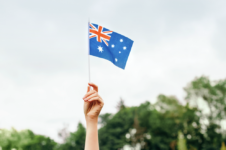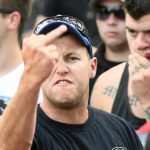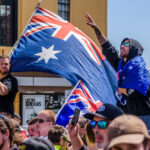A History of Extreme Right-Wing Nationalism in The Lucky Country

Let’s look at the basics; the general tenets of left and right wing politics, which in their more extreme forms are sometimes referred to respectively as socialism or communism on the one hand, and fascism or Nazism on the other.
Although it has been corrupted by authoritarian regimes such as those of Joseph Stalin in the former USSR and perhaps even Xi Jinping in modern-day China, left wing ideology typically puts notions of social, economic and political equality at the fore in the belief that egalitarian rather than exploitative and hierarchical structures, as well as free and diverse belief systems, are for the betterment of society as a whole.
Equally corrupted by fascist regimes such as those of Adolf Hitler in Germany and Benito Mussolini in Italy, right wing ideology typically advocates free enterprise and private ownership, as well as hierarchical social and political structures, and conservative moral belief systems.
So where did these terms come from? And how have they been incorporated in Australian social, economic and political systems?
Origins of the designations
The terms right and left wing came are believed to have originated during the French Revolution of 1789.
At the time, members of the French National Assembly separated; with supporters of the king directed to sit to the president’s right and those supporting the revolution to sit to the president’s left.
The right wing at the time were signified by the desire to uphold existing systems such as hierarchical political structures and conservative morals, whereas the left at the time desired greater quality in political participation and representation, a broader spread of wealth and freedom from oppression.
The designation gradually became synonymous with nationalism and ethnocentrism (politics and ethnicity), capitalism (economics) and conservatism (morals) in the right wing camp, and internationalism, multiculturalism and inclusiveness (politics and ethnicity), socialism (economics) and liberalism (morals) in the left wing camp.
Australian Federation
Fast-forward to Australia at the beginning of the 20th century, where on 1 January 1901 our island moved away from being six self-governing colonies to a federated nation, while remaining part of the British empire.
The colonies to become states were New South Wales, Victoria, Queensland, South Australia, Western Australia and Tasmania, which united to form the Commonwealth of Australia.
Two territories were also established, the Northern Territory and the ACT, each having their own constitution, parliament, government and laws.
It may be interesting to note that two other colonies had the option to join the Australian Federation but chose not to. These were New Zealand and Fiji.
Nationalism at the fore
One of the reasons for the creation of the federation was the establishment of a national identity – together with a culture distinct to the whole of the island and consistent legal and political systems.
While the initial years of federation were signified by tensions between the different jurisdictions, a form of national identity was gradually developed with citizens seeing themselves as Australians rather than a part of their former colonies.
The Russian revolution, Treaty of Versailles, and corruption of communism
1917 saw the uprising of the working class in Russia and the overthrow of the Tsarist regime in Russia.
In what is referred to as the Russian or Bolshevik revolution, Vladimir Lenin and his Bolshevik party took control of the nation ostensibly with the objective of creating an egalitarian society where each person is allocated resources in accordance with their needs, and each contributes according to their abilities.
The movement was inspired by the works of political philosopher and economist Karl Marx and his most influential work Das Kapital, published in three volumes between 1867 and 1883, which predicted the fall of capitalist and authoritarian structures and creation of a society without nation states, unfair economic exploitation or political oppression.
But that idea went out the window fast, with the regime quickly degenerating into authoritarianism, subjugation, exploitation and abominable oppression; led by Lenin’s successor Joseph Stalin from 1922.
The regime came to be as far from communist ideals as can be imagined, whereby the so-called communists hoarded both wealth and power and suppressed the population. Indeed, many refer to the structure as bureaucratic state capitalism.
Around the same time in 1918, Germany’s defeat in World War I resulted in the nation having to sign the Treaty of Versailles which imposed crippling and unsustainable terms of reparations on the nation – resulting in astronomical inflation and sending it into economic peril.
The birth of fascism
Observing the failure of the regime in Russia, many began to expressly reject the viability of a society based on left wing (‘socialist’) ideals and to embrace the idea of nationalism, with an authoritarian leadership whose objective is to, ‘make [insert nation of choice her] great again’.
Thus saw the rise of Benito Mussolini (or ‘Duce’, meaning leader), who founded Italy’s Nationalist Fascist Party and became the Prime Minister of Italy in 1922.
The term ‘fascism’ derives from the Latin ‘fasces’; a bundle of wooden rods that typically included a protruding axe blade. The object would be held by assistants to magistrates in ancient Rome as a symbol of power.
Duce gradually enhanced his power in Italy, ultimately becoming an authoritarian leader whose word was final, while perpetrating atrocities on his people in the name of making Italy great again, as it had been in Roman times.
He used the the outstretched arm as a symbol of unity and respect, and his subordinates wore brown military-style uniforms.
Needless to say, there was a man looking on in awe in Germany who, despite initial setbacks including the Beer Hall Putch in 1923 and his imprisonment as a result of the attempted coup, was biding his time to make a move on power in his nation; re-establishing his Nazi party in 1925.
The rise of Nazism
The popularity of the Nazi Party was waning before the Great Depression in 1929, but that event and its aftermath – which saw millions of Germans lose their livelihoods and fall into poverty – gave the gifted orator the perfect opportunity to build his power.
Hitler ultimately became Chancellor of Germany in 1933 and effectively used misinformation and propaganda to consolidate that power over the years that followed.
His party was called the nationalist socialist party, but its ideals could not be further from socialist and were in fact extreme right wing in nature.
Rejecting the terms of the Treaty of Versailles, Hitler rebuilt the German economy while removing individual freedoms and preaching the ideal of Lebensraum, or living space – the expansion of the Reich to other nations.
That ideal eventually led to hostile actions towards neighbouring countries, culminating in the invasion of Poland and resulting start of World War II in 1939, and the horrendous atrocities that followed.
Adoration of Nazism
Many nations were in awe of the Nazi regime, which showcased its achievements during the 1936 Olympic Games in Berlin.
Indeed, the polished spectacle overshadowed what was occurring under the surface and led world leaders to revere the 1938 Times Person of the Year (Hitler).
In the same year Hitler received the coveted accolade, future Australian Prime Minister Robert Menzies declared, “abandonment by the Germans of individual liberty… has something rather magnificent about it.”
Extreme right wing movements were frequently lauded in our Lucky Country, which had already long implemented a White Australia Policy designed to keep the nation pure and free from what were perceived at the time as harmful outsiders.
Ideas around racial purity and even eugenics – ensuring Australia remains racially ‘pure’ – were widely promoted and accepted at the time, and authoritarianism at the expense of individualism became an objective perceived as ultimately benefiting society as a whole.
And while these notions faded away in the 1940s and 1950s in the wake of the realisation that such views can lead to persecution and even genocide, and were unpopular during civil rights movements of the 1960s, they have seen a revival in the decades thereafter; with a number of groups hijacking and subverting original right wing ideals for their own purposes.
Extreme right wing movements in Australia
Perhaps the re-emergence of the extreme right wing in Australia was signified by the formation of the Neo Nazi Socialist Party of Australia 1967.
National Action (Australia) was established in 1982, a militant white supremacist group that blames the failings and inadequacies of its members on immigrants, and demonises people of other races, religions and sexual orientations, claiming to be victims of these people.
2016 saw the arrival of Antipodean Resistance, an overtly neo-Nazi group, whose flag features a swastika and whose members, as indicated on posters they distributed; incite anti-Jewish, anti-Muslim and anti-homosexual hatred and violence; again seeing these people as the source of their miseries.
The Australian Defence League, founded in 2009 by a convict, is essentially a neo-Nazi street gang, which is not only anti-Islam and has engaged in numerous assaults against Muslim people, but has on many occasions made terrorist threats without repercussion from law enforcement agencies.
The Australian Protectionist Party is a far right anti-immigration party that promotes white nationalism and warns against the threat of Sharia Law; so it is essentially scared that the 3.2% of the Australian population that are Muslims will somehow take over the nation and impose their own legal regime.
The Australia First Party wants a return to a white Australia policy – which was renounced in 1973 – and opposes immigration generally, especially from China.
Australian Liberty Alliance, rebranded as Yellow Vest Australia, vowed to stop the supposed Islamisation of Australia, but was deregistered in 2020.
Pauline brings far right racism into the mainstream
Pauline Hanson’s maiden speech to Parliament took place in 1996, after being elected to the House of Representatives, criticising multiculturalism and making baseless and offensive remarks about the supposed “Asian invasion” of Australia, as well as First Nations people.
The targets of her xenophobic populism later shifted to Muslim and African immigrants, asserting that those who believe in Islam or who derive from African nations should not be allowed to come to Australia and those already here “should go back to where you came from”.
In 2015, the One Nation leader falsely asserted that Islamic Halal Certification was funding terrorism and in 2017, called religious head wear of Muslim woman through her offensive and inflammatory ‘burqa stunt‘.
She even went so far as to make the false and consistently debunked claim that Muslims are responsible for all terrorism in Australia. Indeed, paper after paper has made clear right wing extremism is by far the greatest terrorism threat to our nation.
Popular right wing parties
Populist right wing politics continues to prevail in Australia, with parties such as One Nation, The Great Australian party, Australian Protectionist party and Bob Katter’s Australia party being at the fore.
A number of other such parties have fallen by the wayside in recent years, including the Australian Liberty Alliance and Conservative National Party.
Extreme right wing movements
In terms of extreme right wing parties and movements, the Australian League of Rights, Antipodean Resistance, Lads Society, Soldiers of Odin Australia and True Blue Crew continue to preach their agendas of xenophobia, hatred and violence, although a number of fairly prominent groups, such as New Guard, United Patriots Front, Reclaim Australia and Rise Up Australia.seem to be dwindling or have left the scene.
Right wing extremism: the greatest terrorism threat
The Australian Security Intelligence Organisation (ASIO) through its Director-General, Mike Burgess, stated that threats to the security of Australia from right-wing extremists has increased exponentially over the years, making them the greatest terrorist threat to Australia.
The Director-General’s views are supported by a Parliamentary Joint Committee on Intelligence and Security (PJCIS) Inquiry, which found that younger Australians are increasingly being preyed upon by white supremacists groups, who brainwash the younger population into believing that immigrants are the cause of their plight, rather than anything to do with themselves, the economic situation or their governments.
Indeed, there have been many examples of right wing terrorism both here and across the ditch, as well as instances of right wing terrorists being treated with extreme leniency by the local police and judiciary; including Brisbane man Daniel Fing, Newcastle man Cormac Rothsey, Sydney man Damian O’Neil and of course Reclaim Australia leader Philip Galea; all of whom are Caucasian men.
Except for the last-mentioned man – who was only charged with terrorism after repeated courses of such conduct, none of the other men were charged with terrorism offences despite their crimes clearly falling into that serious category.
By stark contrast, young Muslim men have consistently been charged with terrorism offences carrying maximum penalties of life imprisonment for far less serious conduct than that committed by those mentioned – including one Muslim teenager who was charged with terrorism after being goaded by law enforcement agents into making supposed threats. The teen, unlike all of the mentioned men, did not have weapons, bomb making manuals or anything else that would enable him to carry out the entrapped threats, but did believe in the Islamic faith.
Normalisation of ignorant, dangerous groups
The disdain by white supremacists towards immigrants is despite economists repeatedly and consistently making clear those who come to this country are an enormous benefit to the economy, working hard, taking many of the jobs locals thumb their noses at (including working at farms and orchards for minimal pay) and, indeed, building businesses, employing staff and paying taxes.
Indeed, the primary reason for the revocation of the White Australia Policy was not moral or ethical, it was economic – this nation needed workers, and those immigrant workers have built the economy over decades.
These extreme right wing so-called ‘leaders’ – many of whom are self entitled, narcissistic, bitter Caucasian men who are dissatisfied with their lives through no fault of anyone but themselves – seem to have a ready pool of young people to exert manipulate, indoctrinate, exert power over and use for their own nefarious purposes.
Sadly, there are many instances of the mainstream media presenting right wing extremist groups sympathetically and even in a positive light despite their agendas or xenophobic hate and violence, thereby normalising such extremism.
Countering far right extremism
State and Federal Governments are endeavouring to mitigate the risk associated with right-wing politics, by a joint initiative, Countering Violent Extremism (CVE), with oversight by the Department of Home Affairs.
Although variations of this initiative have seen $120 million invested since 2013, the past several years has seen it given more of a priority status; with Scott Morrison, then Prime Minister allocating $61.7 million in June of 2022.
It involves funding for de-radicalisation, rehabilitation and reintegration of those associated with many of the subversive views of this type of politics, including social media websites promoting community involvement and programs.
Another aspect in the fight against the risk attached to right-wing politics, was a conference in late 2004, The Extreme Right in Twentieth Century Australia; highlighting specific concerns and coinciding with the Liberal Government’s re-election for a third term, at the University of Sydney.
A lot hadn’t been researched about right-wing politics, although a book on the subject in Australia had been published in 1967 by well regarded sociologist, Bob Connell and Florence Gould.
As stated by Andrew Moore, an Australian historian and academic, who lectures at several NSW universities on Australian right-wing politics, about a decade ago, the purpose of studying the history of the Australian right is to know the enemy; proved to be apt, as the book appeared rather light on information, as we know it today.
It certainly registered on the radar after the conference, with Pauline Hanson’s maiden speech to the Australian Senate in 1996 having been dissected.
Sadly, movements signified by hatred and divisiveness that profess to be for the benefit of society have been embraced by many nations across the world, including recently in the United States, with misleading, sensationalist and false proclamations of a need to protect ‘white’ values by demonising others being an easy way for those discontent with their lives to blame others for their plight.







